Peter Dornauf – 4 October, 2015
The current popularity of the lurching somnambulistic automatons speaks of a secular society and its primal fears caught up in a world bereft of belief, thereby needing to reinvent some occult realm to cater for metaphysical longings, but at the same time wanting to keep them at a certain comfortable arms-length. It's a bit like the tickle monster. Frighten me but not too much.
In the sixties, Warhol took the banal commodities of American consumer culture and elevated the products of Western capitalism into high art. In 2002, Mark Curtis, lecturer in graphic design at Wintec, took the trashy product of glitter, the domain of drag queens and 1950’s Christmas cards and did something of the same. He (and his more renowned, fellow glitterati Reuben Paterson) redeemed what was once seen as vulgar and tacky, lifting it out of its lowly status and holding it up into the light of fine art.
Today, kitsch has become the playground for artists wanting to display their deconstructionist credentials with knowing aplomb. But Curtis and Paterson were well ahead of the pack here in New Zealand, doing what Pop Art has given everyone authorization to do and carry further.
Curtis’ recent exhibition at Wallace Gallery, Morrinsville, The Jackson Experiment, reworks various ideas he has been teasing out for a number of years, particularly in regard to the medium of glitter.
For his large pieces Curtis works directly on the floor, an echo of Jackson Pollock’s preferred method or perhaps more precisely the Navajo Indian sand painters. Both these practitioners had religious or mystical preoccupations in mind and so it’s no surprise that there are elements of the same found in Curtis’s floor mural. The 4.5 x 3 meter piece, Jackson - Glitter Carpet, certainly had the wow factor of a stain glass window and in its symmetrical composition suggested something that might attend to Russian icons depicting the Virgin and the saints.
The central figure delineated in the work, however, is the slightly less saintly, Michael Jackson, Son of Neverland and bleached boy of Moonwalk and benzodiazepine fame. Curtis is quick to point out, however, that his Jackson is the pre plastic surgery model, the 1980’s authentic Negroid Michael and author of the all-time bestselling album, Thriller.
So it is the virtuous Michael Jackson face, unadulterated by peroxide and knife that decorates the central tondo portrait in the floor piece, adorned with palm motifs and abstracted floral images that suggest, in part, koru configurations. In many ways it mimics Warhol’s treatment of Marilyn, made into the Madonna and overlaid with camp. Here is the same secularized account of a twentieth century idol/god, given a demythologized workout, using the medium of glitter, itself associated with the world of razzle-dazzle, hype and hyperbole, self-consciously artificial and over-the-top extravagant.
The construction of the work is carefully controlled using stencils and involves, appropriately, two royal colours - silver and blue, the glitter being placed on the floor with the aid of large salt shakers. The end product is a sight to behold, worthy of being displayed on the floor or in the window of any Roman Catholic cathedral. Its glitter base simply serves to remind the viewer of the glitzy, ritualistic pomp and splendour associated with the high church that equally employs all the ostentatious and tawdry visual tricks in its repertoire to persuade the faithful to keep the faith.
There is thus in Curtis’s oeuvre a double declutching move that at one and the same time mocks and admires the subject and medium of his material. Indeed the artist has revealed he is the proud owner of a suitably embossed and stamped certificate, purchased on the net for a small fee which proclaims he belongs to the offices of an ordained minister of the Universal Life Church, Modesto, California. Their website declares that you’ve come to the right place of you’re wondering how to become an ordained minister, “within seconds”, no experience necessary. Notable ULC ministers include Joan Rivers and Johnny Carson among 20 million others and induction comes complete with T shirt and wallet card.
The ‘Reverend’ Curtis, however, is a man who has singularly abjured the cloth, unlike Paterson who works on canvas. Using the floor as ground thus means that the art, by nature, is ephemeral. The brush and shovel will have the final say, which seems fitting for such a sassy art that elevates and deflates all in the same move. It is a practice that cleverly conflates profundity and superficiality while taking high and low to new heights and depths and gives them a decent twirl. All that glitters is not gold, but Curtis certainly has the Midas touch when it comes to making something that means so little and yet so much at the same critical and indelible moment.
Zombies have the same trashy component, beloved of pulp pop culture and The Jackson Experiment continues with Curtis alluding directly to the 1986 Thriller album in a series of works (Army of the Dead) that employs the lenticular photographic technique. This visual trick was originally used in novelty items called “flicker” or “wiggle pictures”. Remember those slightly risqué pens back in the day which at a flick of the wrist, innocent, under-aged boys could dress and undress the image of some nubile scantily clad woman.
Curtis invited visitors to the gallery to don the gear of the gloved one, supplying afro wig, glasses and Thriller red jacket, after which he photographed each participant, then superimposed various ghoulish zombie-like images over the original with the lenticular process.
Walking past the photos on the gallery wall provides that transformative moment when fresh faced normality shifts into a macabre register of skull and grisly teeth. Life imitated art literally in Jackson’s case on so many levels. But the work also reflects on life and death in the 1980’s for the gay community where the skull for so many, in the age of the AIDs epidemic, lurked just beneath the skin.
What does one do with such a distressing reality? One makes friends with it by making jokes, creating ironic distance by turning it into a theatrical farce. In other words, one camps it up, which perhaps for some, operates as a form of collective therapy. Thriller, with all its hokey B-grade movie shtick, gave disco a dose of hammer horror melodrama and Curtis returns the favour in his morbid but trickster-like morphing prints.
The current popularity of the lurching somnambulistic automatons speaks of a secular society and its primal fears caught up in a world bereft of belief, thereby needing to reinvent some occult realm to cater for metaphysical longings, but at the same time wanting to keep them at a certain comfortable arms-length. It’s a bit like the tickle monster. Frighten me but not too much.
Death, the last taboo, is thus confronted obliquely with a degree of playful mischievousness, acting out the artful language game. It’s the postmodern way. Gone the existential anguish and hand-wringing to be replaced with a lightness of touch, an impish bravado where we hold our nerve by holding hands in a dance that moves backwards while appearing to move forwards, lip-synching to some multi-layered techno-infused pastiche.
The artist follows all the pomo tricks, making it banal then exploiting it, dropping it inside quotations, dressing it up in parody, making a spectacle with lashings of glitter, dipping the toe in nihilism with a Vincent Price laugh.
Curtis realises this again with his skull series. The skull is back but dripping in jewels. These are Damien Hirst inspired works, sculptural forms, identical and multiple, lined up on the wall like Warhol’s soup cans and covered in glitter of various tints and hues. Death never looked so pretty. These are not memento mori pieces but the antithesis. This is about forgetting death, blunting the fear by blasting it with a glitter bomb and repeating the process twenty times over in various twinkling colours.
Warhol said once, in relation to his Death and Disaster series, that what he was doing was showing how the media had become complicit in diminishing the emotional reservoir of human feeling simply by the act of repetition. The tear ducts of the world, he claimed, had as a consequence, dried up.
Curtis, in his mannered and histrionic moves, achieves the same, with a parallel effect, at least for the duration spent in the gallery. The Jackson Experiment passes the test with flying colours, proving that glitter, that despised and most rejected of substances, which we hid, as it were, our faces from, has on its own terms the pizzazz to carry our sorrows and shoulder our griefs.
Peter Dornauf
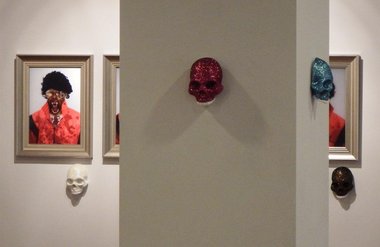
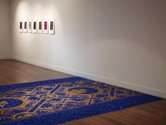

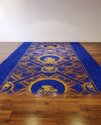
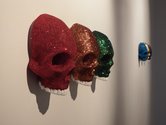


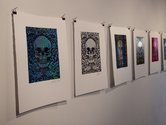
 Advertising in this column
Advertising in this column Two Rooms presents a program of residencies and projects
Two Rooms presents a program of residencies and projects



This Discussion has 0 comments.
Comment
Participate
Register to Participate.
Sign in
Sign in to an existing account.